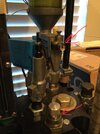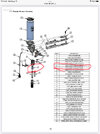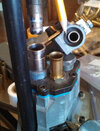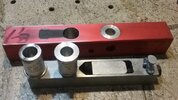First off don't talk me out of this, I know what I want lol.
I want powder bars for a dillon style powder measure that have fixed/ interchangeable bushings for certain loads.
I HATE adjustable bars as creeping has always been a issue despite additional wavy washers and carefully monitoring.
My last batch of 1000 45 acp went from 5 grains of bullseye to 6 grains around the 600ish round mark. Still a safe load of lead BUT WAY TOO HOT AND SNAPPY for my tias 1911.
I think I can build these on a milling machine out of brass , if anyone has attempted this before please share the experience
I want powder bars for a dillon style powder measure that have fixed/ interchangeable bushings for certain loads.
I HATE adjustable bars as creeping has always been a issue despite additional wavy washers and carefully monitoring.
My last batch of 1000 45 acp went from 5 grains of bullseye to 6 grains around the 600ish round mark. Still a safe load of lead BUT WAY TOO HOT AND SNAPPY for my tias 1911.
I think I can build these on a milling machine out of brass , if anyone has attempted this before please share the experience





